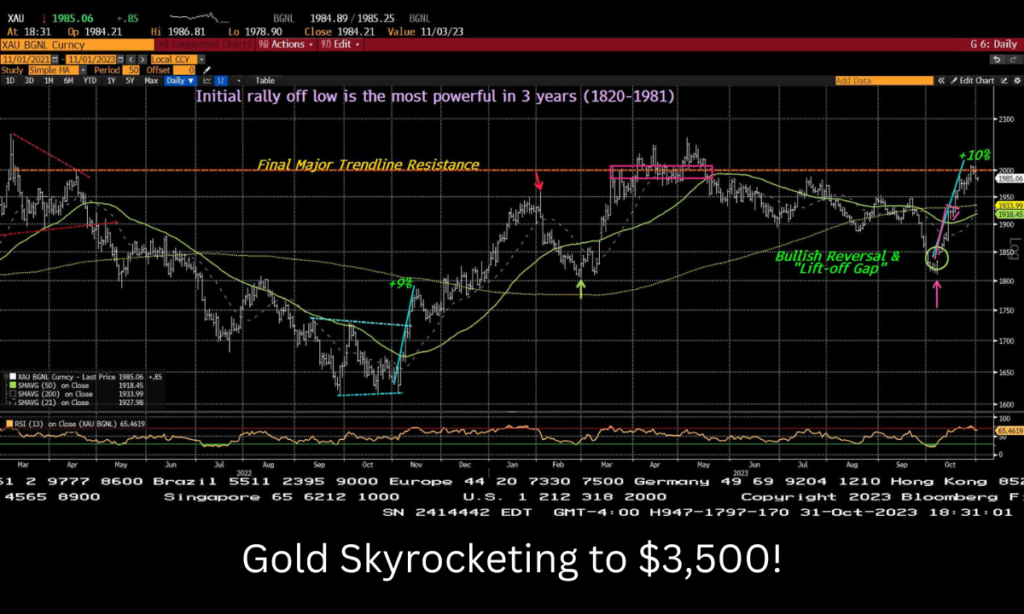Discover the hidden secrets in charts that might make gold go up to $3,500! This exciting possibility encourages us to take a closer look at the special signs and patterns in charts that could lead to a big increase in the price of gold.
The idea of gold reaching $3,500 per ounce depends on understanding signals in the charts that suggest positive trends and good conditions in the market. People who study charts, like technical analysts and investors, carefully look at these hidden secrets to guess if the value of gold might go up.
Finding these hidden chart secrets means looking at old data, finding important levels where the price might stop going up or down, and understanding tricky chart patterns. The chance of gold going to $3,500 shows how much looking at charts matters to predict what might happen in the market and make smart choices for investments.
As people figure out these secret chart hints, the future of gold’s value becomes like an interesting puzzle, making investors think about the possibilities and plan their moves to benefit from possible increases.
Introduction:
Uncover the Hidden Chart Secrets That Could Send Gold Skyrocketing to $3,500!. In this comprehensive analysis, we explore the recent developments in the gold market and what the charts suggest about its future trajectory. On October 17th, a significant bullish reversal occurred, prompting a Buy signal for gold, and our work indicates the potential for new highs in the coming months. We will delve into the technical aspects of this analysis, considering both the daily and monthly charts, and discuss potential strategies for investors.
The Bullish Reversal and Liftoff Gap
In the world of technical analysis, chart patterns and signals can provide valuable insights into an asset’s future direction. On October 17th, gold displayed a powerful bullish reversal from its support at $1,811. This reversal was characterized by higher highs than the prior day, lower lows than the previous day, and a close above the prior day’s high. Such patterns are typically seen when prices end a decline and embark on a new uptrend. Furthermore, this bullish reversal was accompanied by a “liftoff gap,” where gold opened above the prior day’s high and closed significantly higher than its recent low at $1,811. We will explore the significance of these patterns and what they imply for gold’s future.

Overcoming Resistance Levels
One of the key indicators of a strong bullish trend is the ability to overcome resistance levels. After the bullish reversal, gold’s rally took it to the 200-day moving average in the $1,930 area. Following a brief period of sideways trading action, gold decisively hurdled both the price and 200-day moving average resistance at $1,940. This transition not only signaled a reversal from a neutral to a bullish trend but also generated upside projections, suggesting that gold could reach $2,050. We will delve deeper into the importance of these resistance levels and how they can impact future price movements.
The Long-Term Monthly Chart
To gain a more comprehensive view of gold’s potential, we must consider its long-term performance. For the past 12 years, gold has been trading within a range of approximately $1,000 to $2,000. However, what makes this situation particularly bullish is that within this long base, gold has been forming progressively higher trading ranges. Moreover, each consolidation phase has been shorter than the previous one. This trading pattern is often indicative of what occurs before a strong upside breakout. We will analyze these long-term trends and what they suggest about the future of gold.
Strategy for Investors
As the analysis unfolds, it becomes clear that gold has a strong support level in the $1,900 to $1,925 range. Based on this support and the technical indicators discussed, our analysis indicates that gold could be testing its previous record high of $2,075 in the next few months, possibly even by year-end. Furthermore, if gold manages to achieve a monthly close above $2,100, the analysis projects the potential for a long-term advance to $3,500 or more. We will explore the investment strategies that can be adopted in light of these projections.
FAQs: Gold Price Analysis and Investment Strategies
What is a bullish reversal in technical analysis, and why is it significant?
A bullish reversal in technical analysis refers to a pattern in which an asset’s price shows higher highs, lower lows, and a close above the prior day’s high, indicating a potential shift from a downtrend to an uptrend. It’s significant because it suggests a change in the asset’s direction and can be a strong buying signal for investors.
What is a “liftoff gap” in the context of chart analysis?
A “liftoff gap” occurs when the price of an asset opens above the prior day’s high and closes significantly higher than its recent low. This pattern is typically observed when an asset is transitioning from a declining phase to an upward trend, signifying a strong buying interest and positive sentiment among investors.
How do resistance levels impact an asset’s price movement?
Resistance levels are price levels where an asset has historically struggled to move above. When an asset successfully breaks through these resistance levels, it often indicates a significant change in the prevailing trend, potentially triggering increased buying activity and driving the price higher.
What is the significance of the 200-day moving average in technical analysis?
The 200-day moving average is a widely used technical indicator that smoothes out price fluctuations over the past 200 days. It is significant because it helps identify long-term trends. When an asset’s price crosses above the 200-day moving average, it can signal a shift in sentiment and often suggests a bullish trend is developing.
Can you explain the concept of progressively higher trading ranges in a long-term chart?
Progressively higher trading ranges refer to a pattern where an asset’s price consolidations or ranges between highs and lows are gradually increasing over time. This pattern is a positive sign as it suggests growing price momentum and may indicate that the asset is building up for a substantial upward breakout.
What are the potential risks and uncertainties that investors should consider when looking at gold’s future price movements?
Potential risks and uncertainties in the gold market can include economic instability, geopolitical events, changes in interest rates, and fluctuations in currency values. Investors should also consider market sentiment and the potential for unforeseen events that could impact gold prices.
How can investors take advantage of the projected gold price increase to $2,075 and beyond?
Investors can consider various strategies to capitalize on the projected increase in gold prices, such as investing in physical gold, gold ETFs, or gold mining stocks. Diversifying a portfolio with gold can help hedge against economic volatility and currency devaluation.
What external factors, such as economic conditions or geopolitical events, might influence gold’s price in the near future?
Several external factors can influence gold prices, including economic conditions such as inflation, interest rates, and the strength of the U.S. dollar. Geopolitical events, like conflicts and trade disputes, can also have a significant impact on gold prices, as investors often turn to gold as a safe-haven asset during times of uncertainty. Monitoring these factors is crucial for understanding potential price movements in the gold market.
In conclusion
Gold’s recent bullish reversal and technical indicators suggest a promising path toward new highs. Investors should carefully consider their strategies in light of these projections and keep an eye on the factors that can influence gold’s performance in the coming months.
